Elimination of the Solid Graininess Issue with Different Micro-Pattern Structures at Flexo Printing
Abstract
:Featured Application
Abstract
1. Introduction
2. Materials and Methods
- Digital plate-making,
- Flexographic printing,
- Measurement process.
2.1. Digital Plate-Making
- Digital Imager (CtP Device): ESKO CDI Spark 4835 (ESKO, Ghent, Belgium);
- Resolution: 4000 dpi;
- Photopolymer: DuPont Cyrel EFX 045 Digital Plate;
- Plate thickness: 1.14 mm;
- Plate Exposure UV-A Output: 22 mW/cm2;
- Line ruling: 150 lpi;
- Screen angle: 37.5°;
- Screening type: Circular AM;
- Micro-pattern line rulings: 1000 lpi, 1500 lpi;
- Pattern angle: 45°.
2.2. Printing
- Flexo press: Omet XFlex X4
- Printing Speed: 80 m/min;
- Flexo ink: Flint Group Flexocure Force UV cyan;
- UV Curing: UV Lamp, 600 WPI output power (Watts Per Inch);
- Printing width: 330 mm;
- Printing length: 419 mm;
- Anilox line count: 375 L/cm (950 lpi);
- Anilox cell volume: 3.1 BCM (Billion Cubic Microns);
- Plate mounting type: Tesa 72,022 medium soft, Tesa 72,026 medium hard, 0.38 mm thickness;
- Substrates: PVC (polyvinyl chloride) film and PET (polyethylene terephthalate) film. Pre-treatment applied PET surface energy 42 dynes/cm and PVC film surface energy of 46 dynes/cm.
- PET: Clear PET film. Basis weight 105 g/m2 (ISO 536), caliper 75 μm (ISO 534).
2.3. Preparation of Test Plate
2.4. Designing of Micro-Patterns
2.5. Measurements
- Measurement Geometry: 45°/0° ring illumination optics, ISO 5-4:2009(E) [21].
- Spectral Range: 400 nm to 700 nm with 10 nm interval
- Aperture: 2 mm
- Short-Term Repeatability—Density:
- +/−0.01 D for CMYK measurements (non-polarized @ 2.0D)
- +/−0.01 D for CMK measurements (polarized @ 2.0D)
- +/−0.01 D for Y measurements (polarized @ 1.7D)
- (Status E or Status T measurements)
2.6. SID (Solid Ink Density)
3. Results and Discussion
4. Conclusions
Author Contributions
Funding
Institutional Review Board Statement
Informed Consent Statement
Data Availability Statement
Conflicts of Interest
References
- Liu, X.; Guthrie, J.T. A review of flexographic printing plate development. Surf. Coat. Int. Part B Coat. Trans. 2003, 86, 91–99. [Google Scholar] [CrossRef]
- Keşan, N. Analysis of Parameters of Preproduction and Platemaking in Flexo Printing. Master′s Thesis, Marmara University, Istanbul, Turkey, 2008. [Google Scholar]
- Lorenz, A.; Senne, A.; Rohde, J.; Kroh, S.; Wittenberg, M.; Krüger, K.; Biro, D. Evaluation of flexographic printing technology for multi-busbar solar cells. Energy Procedia 2015, 67, 126–137. [Google Scholar] [CrossRef]
- Morisse, P.; Wolfgang, S. Method for Smoother Tonal Response in Flexographic Printing. U.S. Patent No. 11,142,013, 8 October 2021. [Google Scholar]
- Bielak, R.R. Flexographic Surface Patterns. U.S. Patent No. 9,235,126, 8 October 2014. [Google Scholar]
- Zhong, Z.W.; Ee, J.H.; Chen, S.H.; Shan, X.C. Parametric investigation of flexographic printing processes for R2R printed electronics. Mater. Manuf. Process. 2020, 35, 564–571. [Google Scholar] [CrossRef]
- Havenko, S.; Ohirko, M.; Ryvak, P.; Kotmalova, O. Determining the Factors That Affect the Quality of Test Prints at Flexographic Printing. East. Eur. J. Enterp. Technol. 2020, 2, 53–63. [Google Scholar] [CrossRef]
- Joshi, A.V. Optimization of flexo process parameters to reduce the overall manufacturing cost. Int. J. Optim. Control Theor. Appl. (IJOCTA) 2022, 12, 66–78. [Google Scholar] [CrossRef]
- Johnson, J.; Andersson, C.; Lestelius, M.; Jarnstrom, L.; Ratto, P.; Blohm, E. Some properties of flexographic printing plates and aspects of print quality. Appita Technol. Innov. Manuf. Environ. 2009, 62, 371–378. [Google Scholar]
- Assaifan, A.K.; Ahmad, I.; Alshehri, N.A.; Alharbi, H.F. Scaling-up medical technologies using flexographic printing. Talanta 2020, 219, 121236. [Google Scholar] [CrossRef] [PubMed]
- Bates, I.; Zjakic, I.; Budimir, I. Assessment of the print quality parameters’ impact on the high-quality flexographic print visual experience. Imaging Sci. J. 2015, 63, 103–110. [Google Scholar] [CrossRef]
- Olsson, R.; Yang, L.; Stam, J.; Magnus, L. Effects on ink setting in flexographic printing: Coating polarity and dot gain. Nord. Pulp Pap. Res. J. 2006, 21, 569–574. [Google Scholar] [CrossRef]
- Fang, E.; Ge, J. Research on the Solid Screening with Microcell Technology in the Flexographic Printing. In Proceedings of the 9th China Academic Conference on Printing and Packaging and Conference of Scientific Research Innovation, Jinan, China, 16–19 November 2018; pp. 543–550. [Google Scholar] [CrossRef]
- Várza, F.; Preklet, E.; Horváth, C. Application Analysis of White Flexographic Printing Inks on Biodegradable Flexible Foils. In Proceedings of the 2nd International Conference on Circular Packaging (2nd CPC), Slovenj Gradec, Slovenia, 9 September 2021; pp. 311–320. [Google Scholar] [CrossRef]
- Brumm, P.; Sauer, H.M.; Dörsam, E. Scaling Behavior of Pattern Formation in the Flexographic Ink Splitting Process. Colloids Interfaces 2019, 3, 37. [Google Scholar] [CrossRef]
- Valdec, D.; Hajdek, K.; Majnarić, I.; Čerepinko, D. Influence of printing substrate on quality of line and text reproduction in flexography. Appl. Sci. 2021, 11, 7827. [Google Scholar] [CrossRef]
- TAPPI T402 SP-13; Standard Conditioning and Testing Atmospheres for Paper, Board, Pulp Handsheets, and Related Products. Technical Association of the Pulp and Paper Industry (TAPPI): Peachtree Corners, GA, USA, 2013.
- ISO 536; Paper and Board—Determination of Grammage. International Organization for Standardization (ISO): Geneva, Switzerland, 2019.
- ISO 534; Paper and Board—Determination of Thickness, Density and Specific Volume. International Organization for Standardization (ISO): Geneva, Switzerland, 2011.
- FlintGroup Flexocure Force Process Cyan UFO5-0082-408N Specifications. Available online: https://www.cmyklinik.com/4531544 (accessed on 29 July 2024).
- ISO 5-4:2009; Photography and Graphic Technology—Density Measurements. International Organization for Standardization (ISO): Geneva, Switzerland, 2009.
- ISO 13655-2009; Graphic Technology—Spectral Measurement and Colorimetric Computation for Graphic Arts Images. International Organization for Standardization (ISO): Geneva, Switzerland, 2009.
- Şahinbaşkan, T.; Gençoğlu, E. Color and Color Management in Printing Industry; Odak Kimya Endüstri San.Tic.Ltd Şti: Istanbul, Türkiye, 2010; ISBN 978-605-88733-0-8. [Google Scholar]
- Kurt, M.B.; Mumcu, Y.K.; Özdemir, L. Estimation of screen density according to different screening methods with artificial neural network method in flexo printing. J. Polytech. 2018, 21, 575–580. [Google Scholar]
- Deganello, D.; Cherry, J.A.; Gethin, D.T.; Claypole, T.C. Patterning of micro-scale conductive networks using reel-to-reel flexographic printing. Thin Solid Film. 2010, 518, 6113–6116. [Google Scholar] [CrossRef]


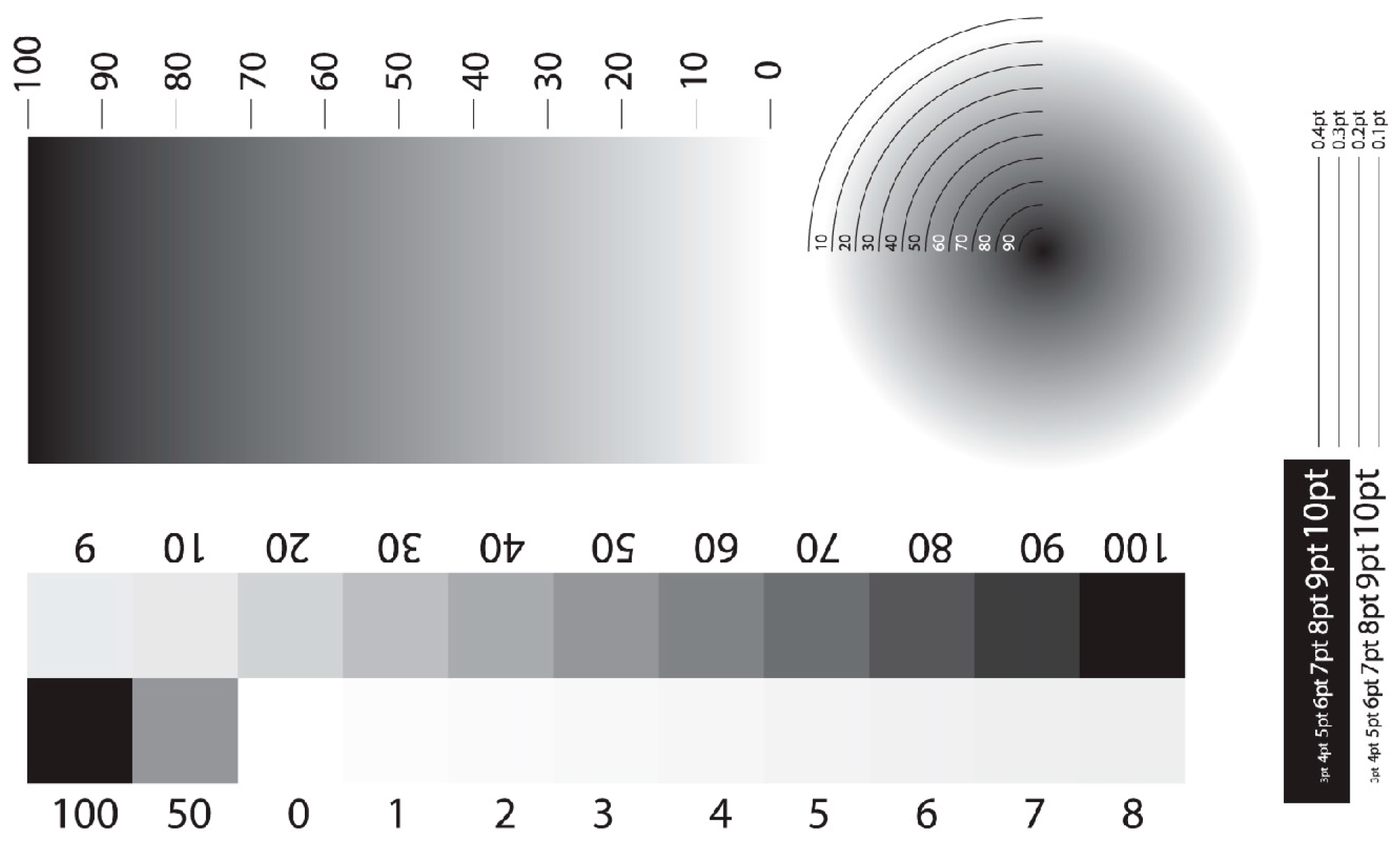
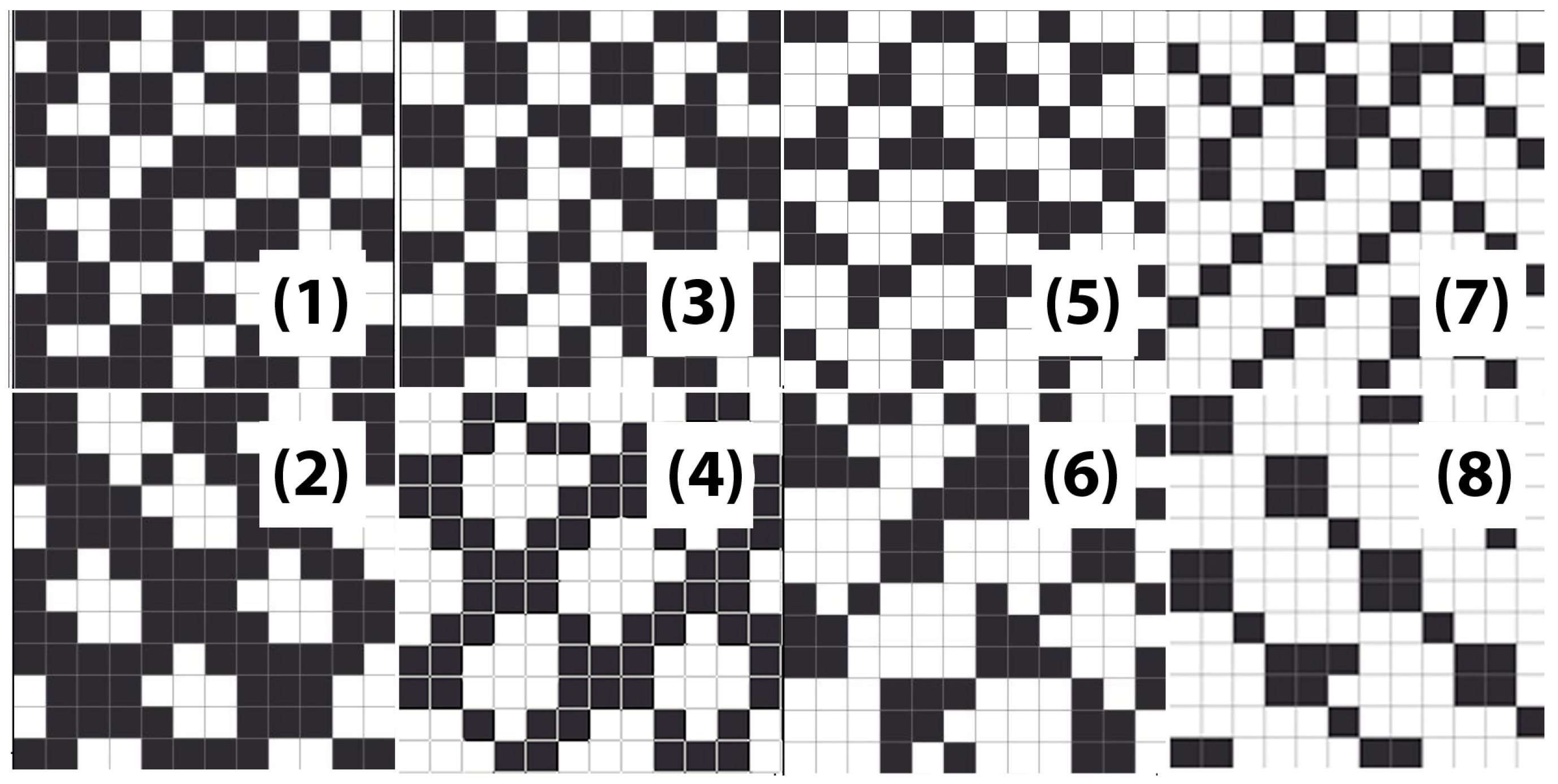

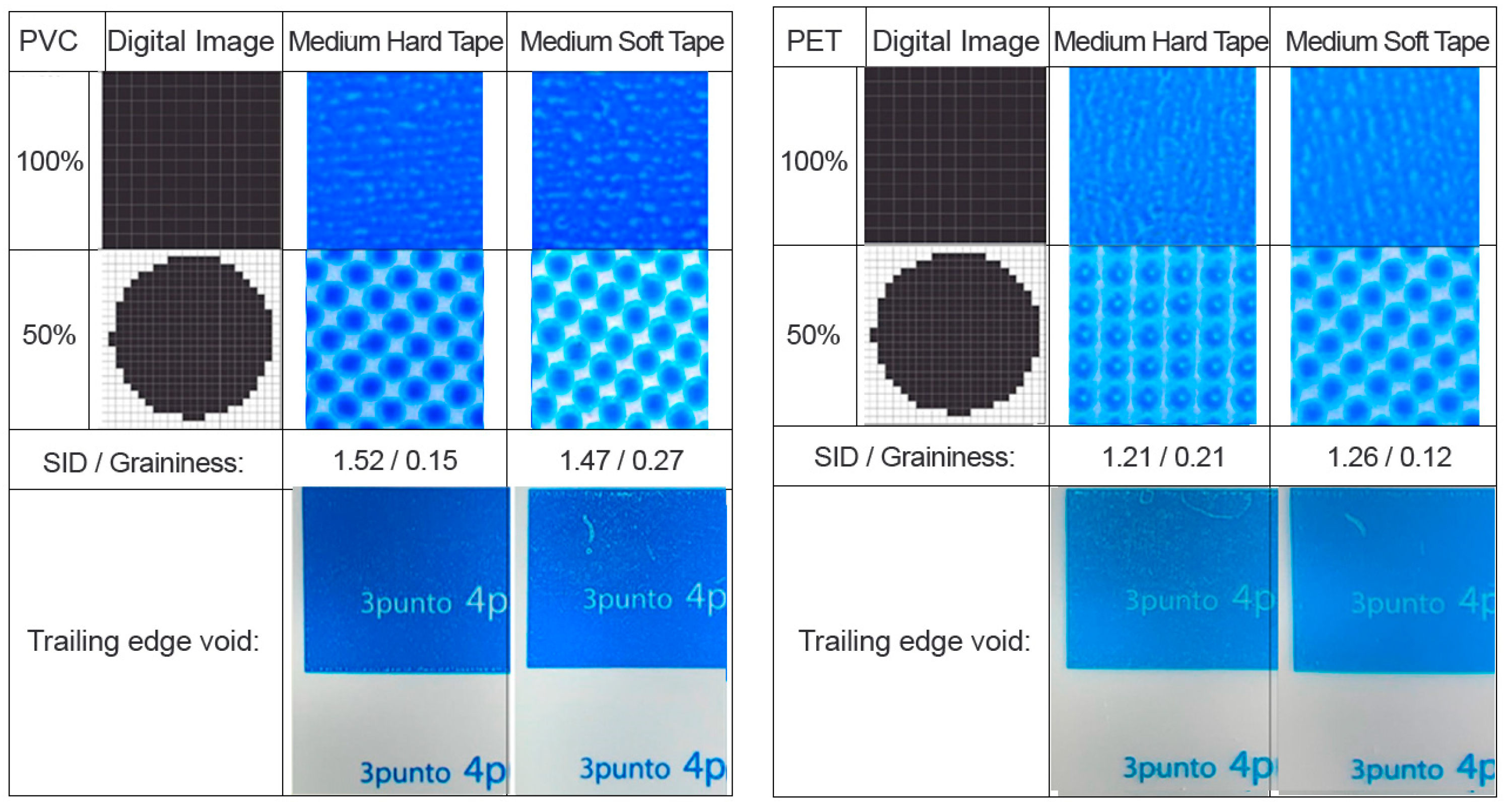
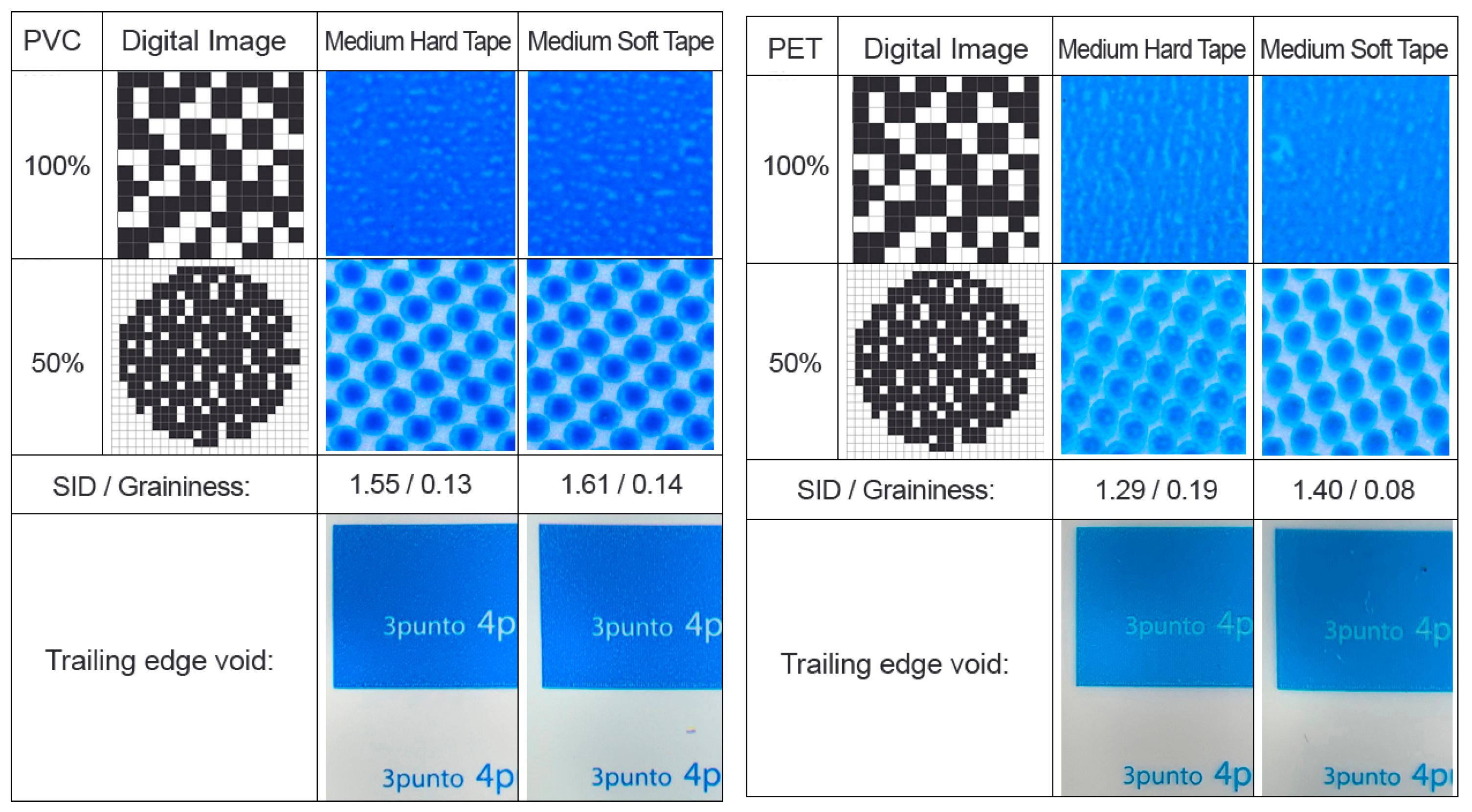
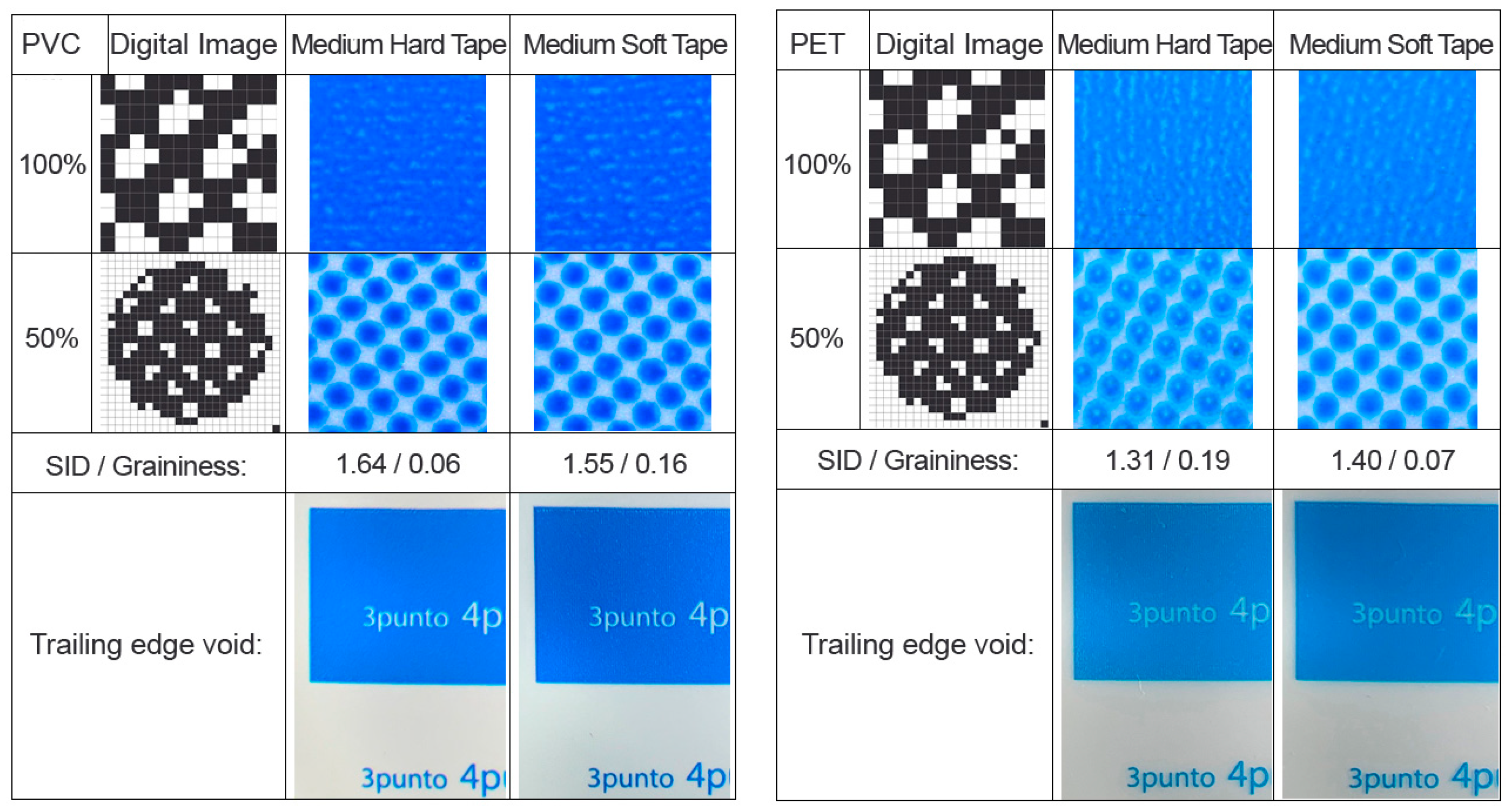



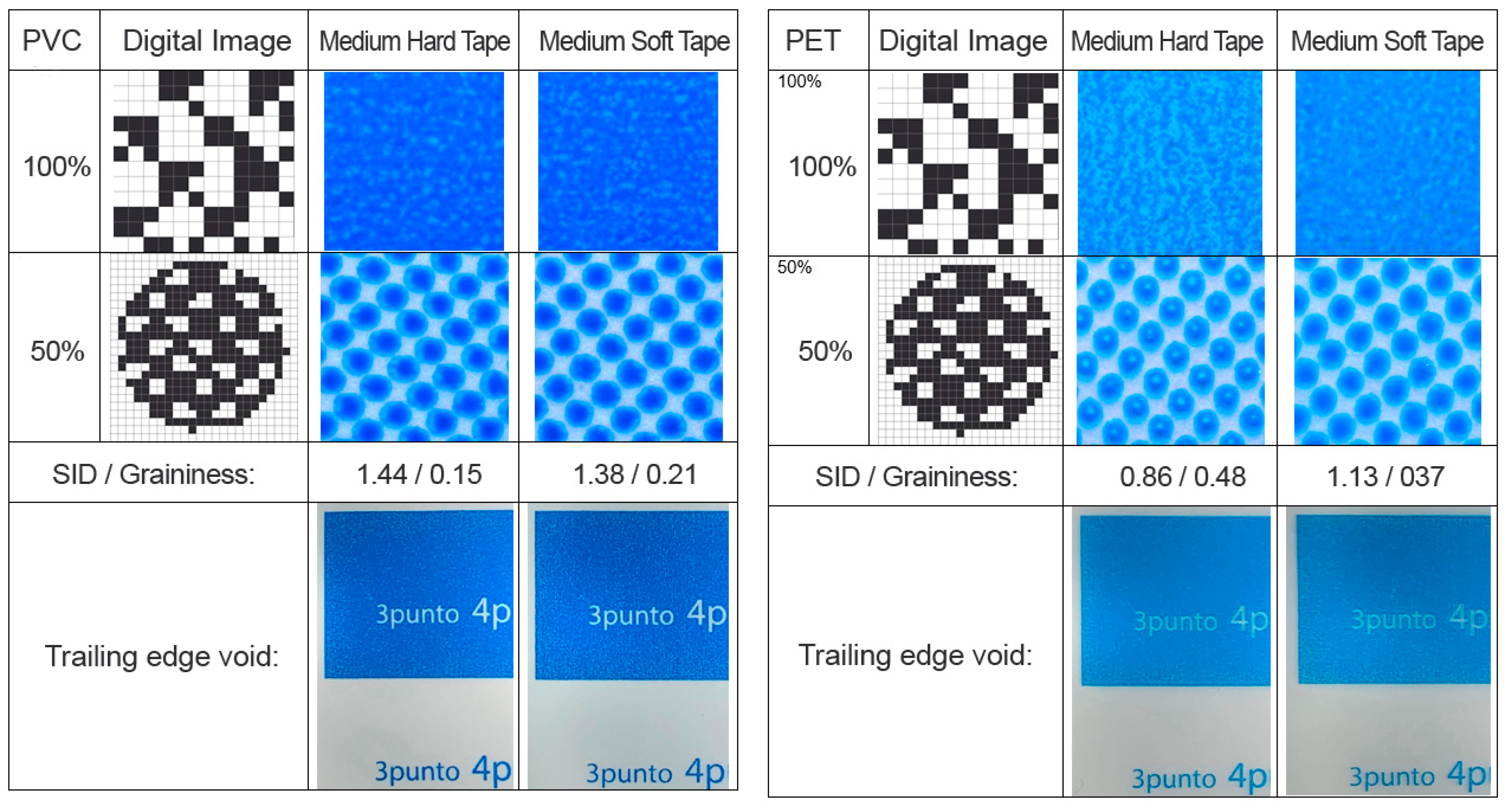
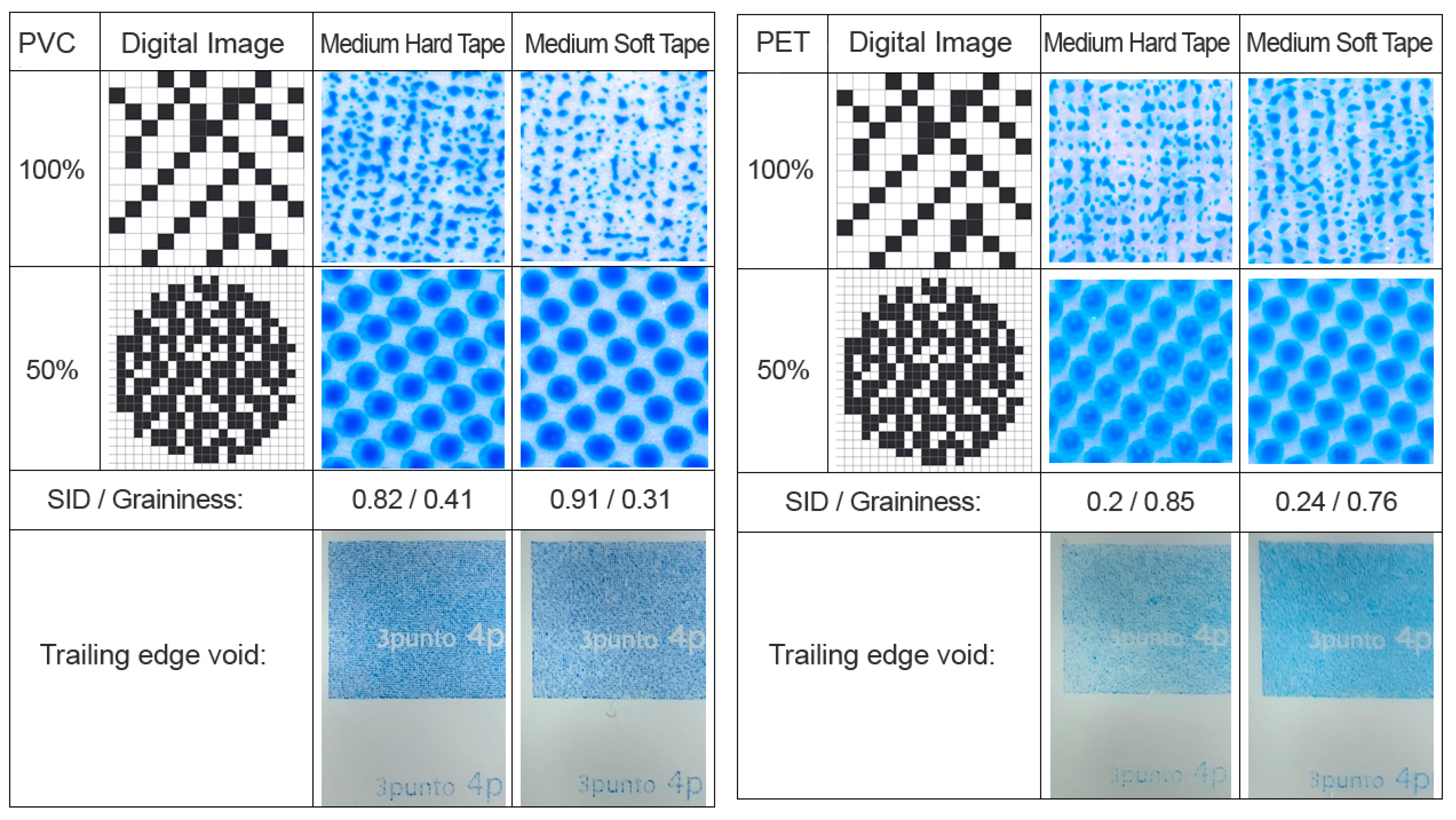


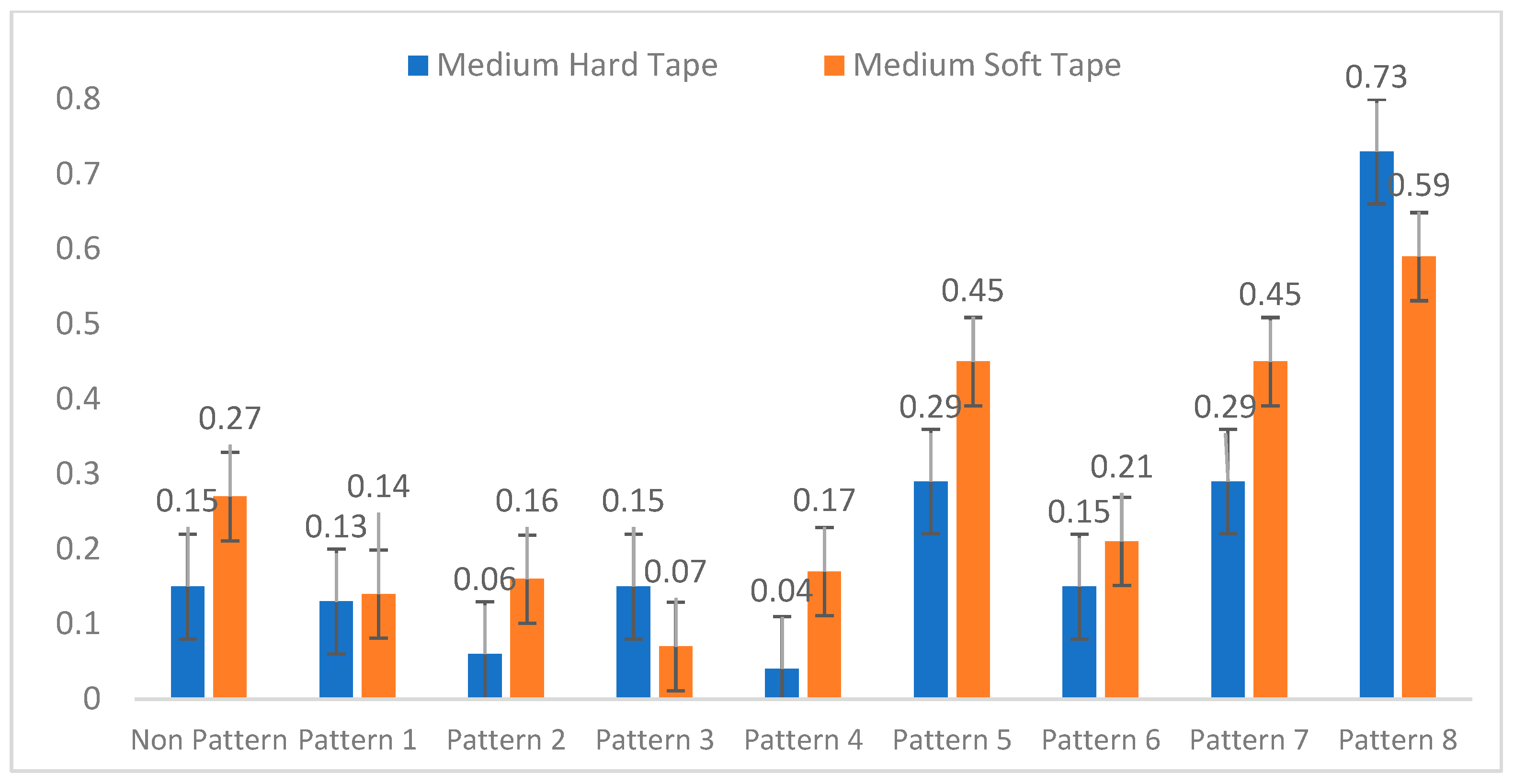

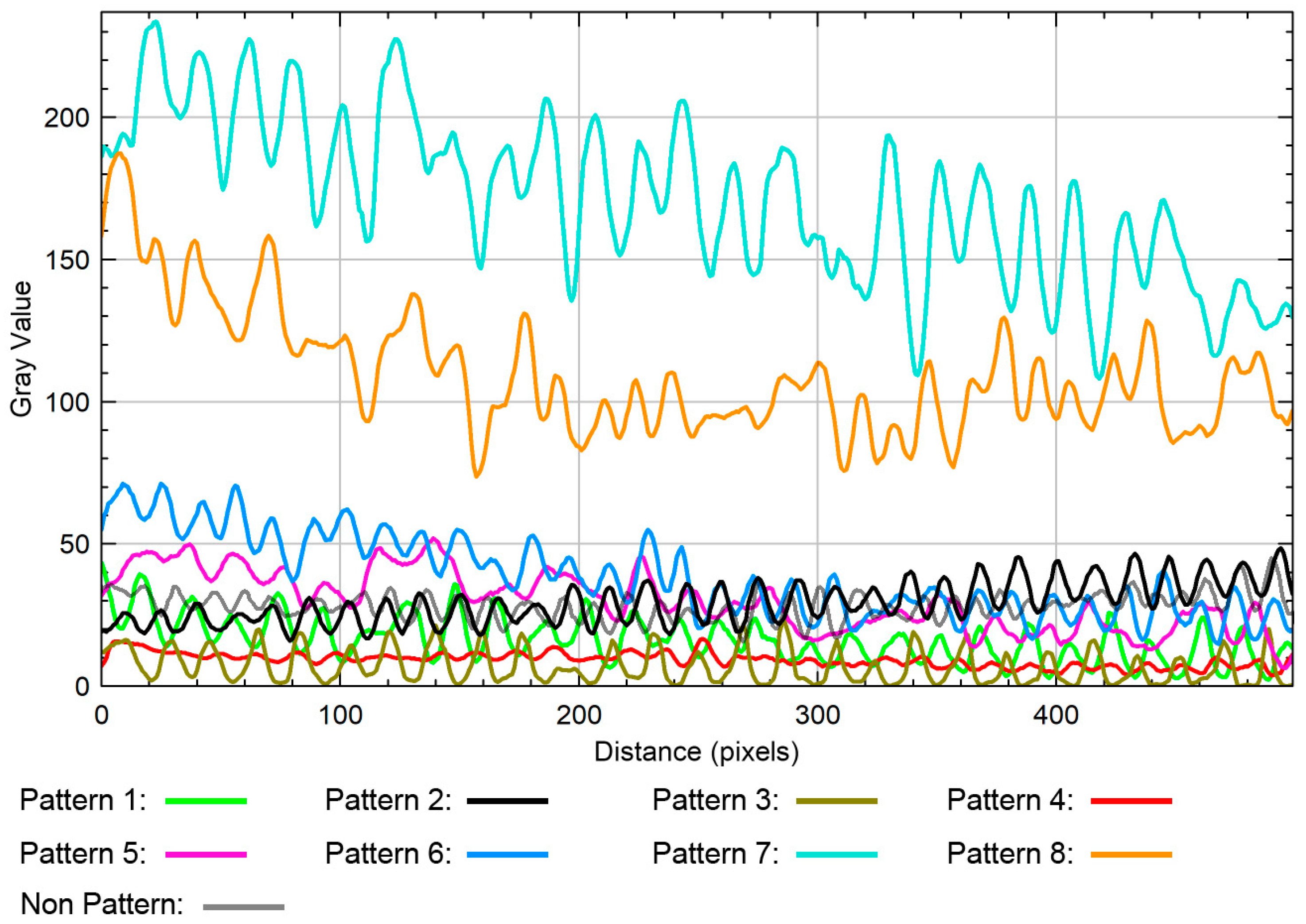
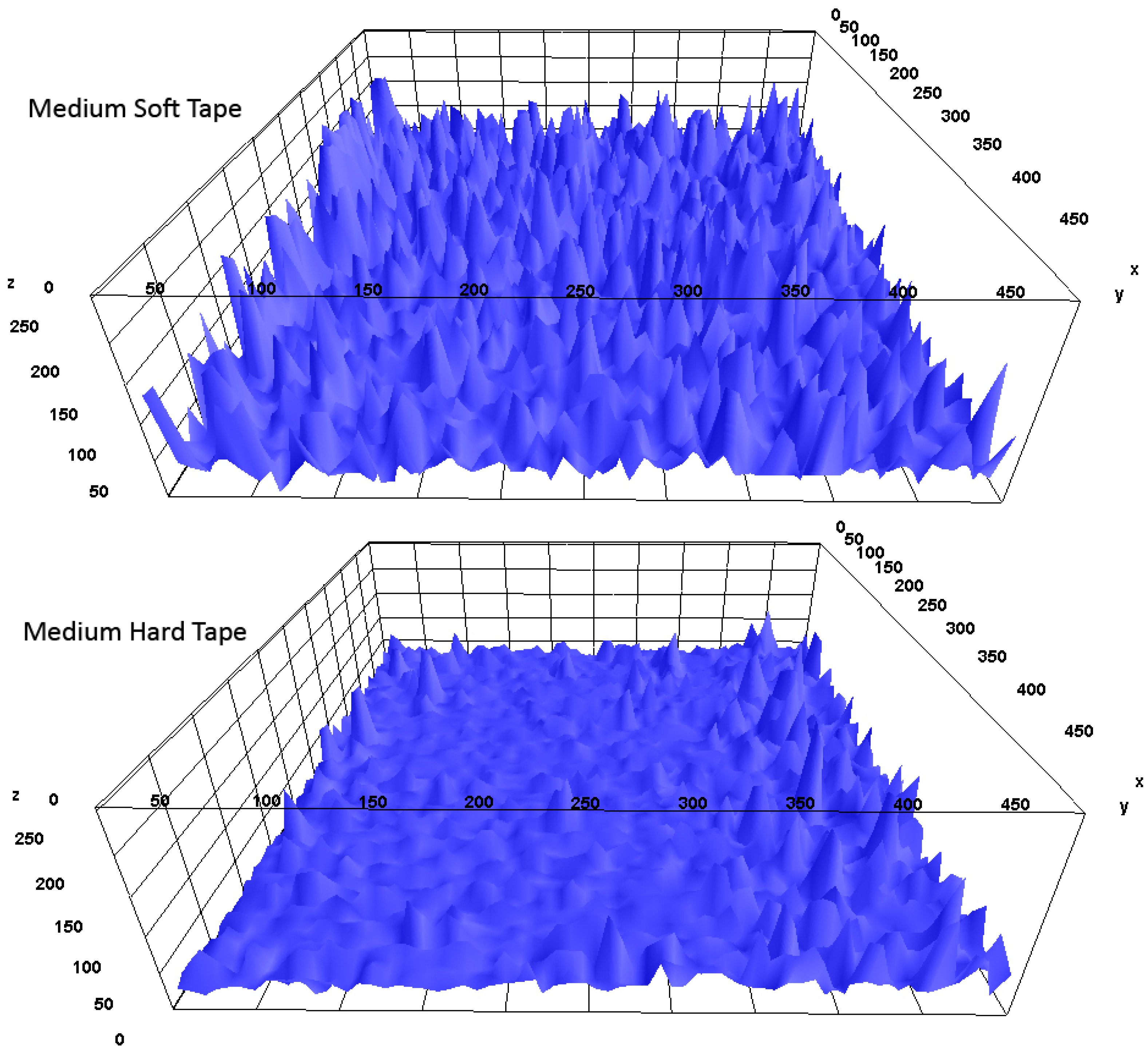
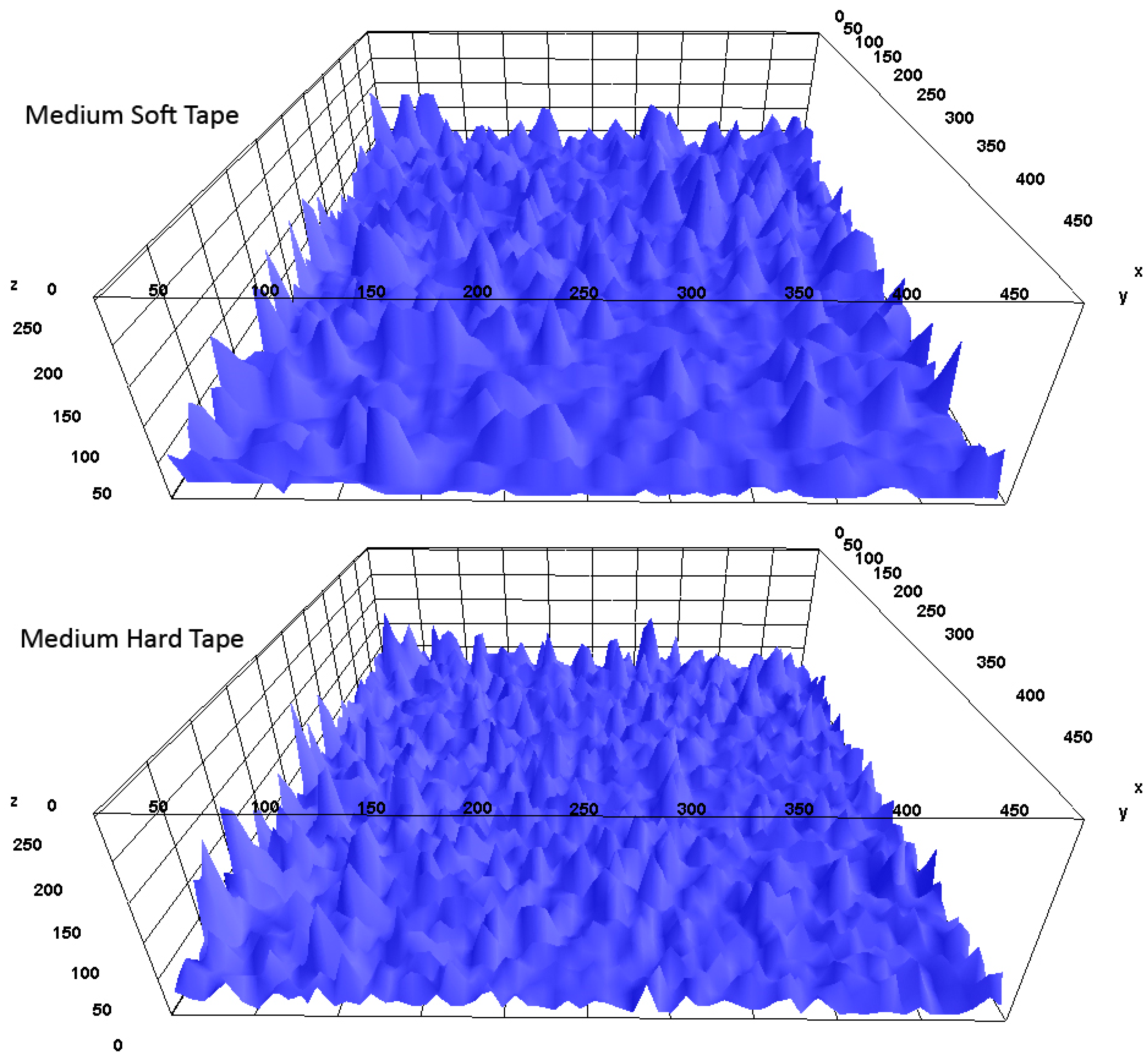
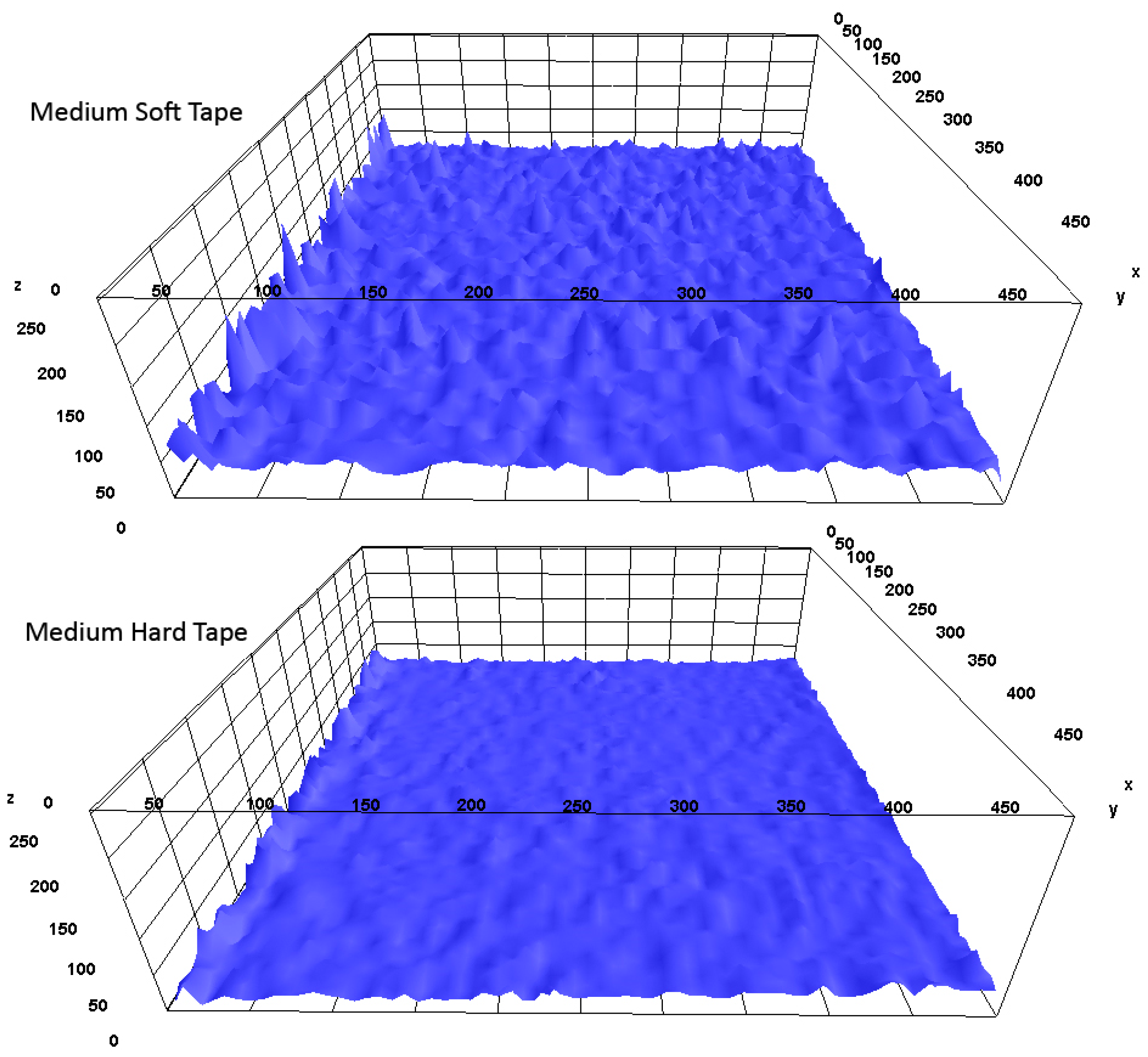
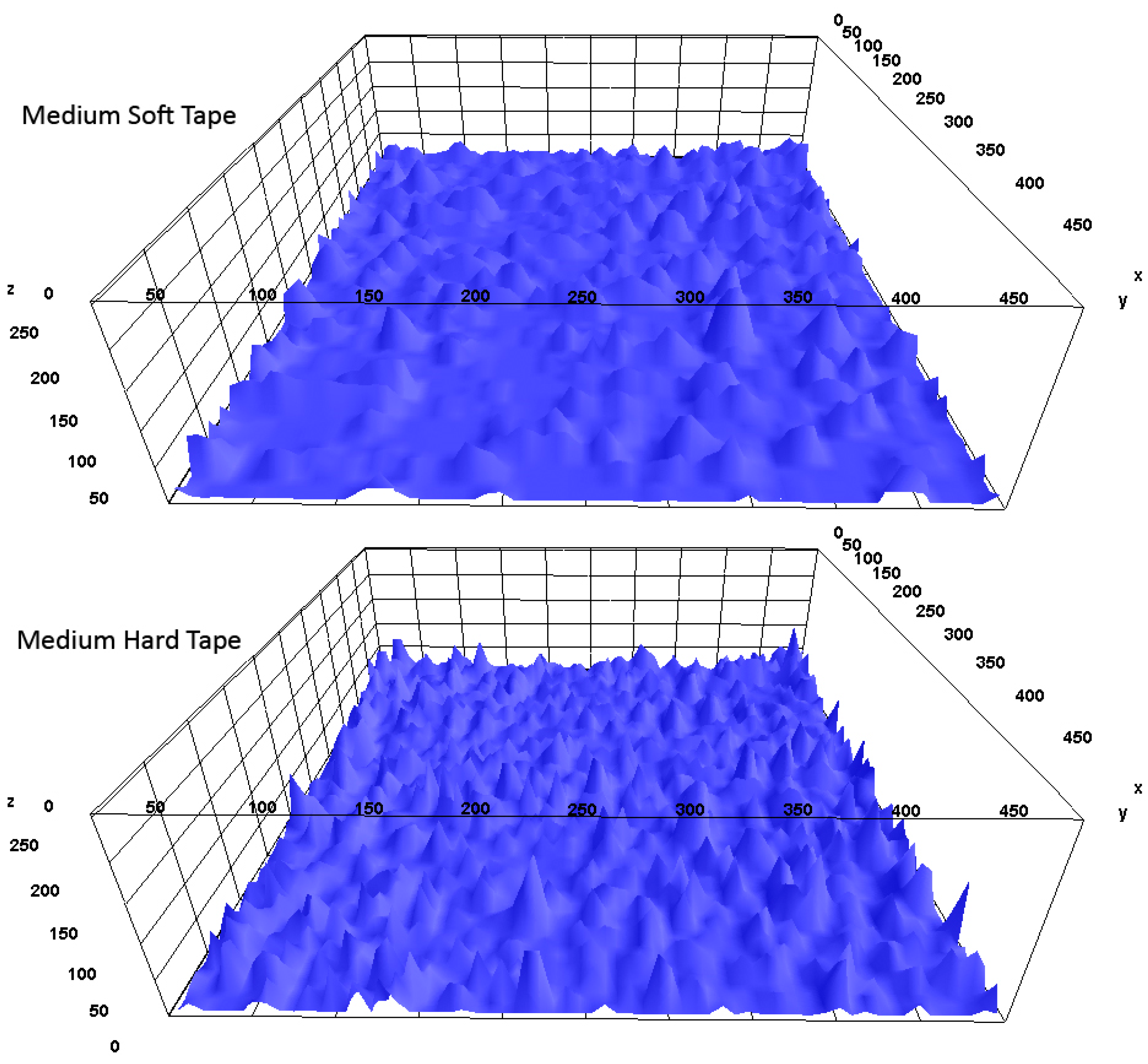
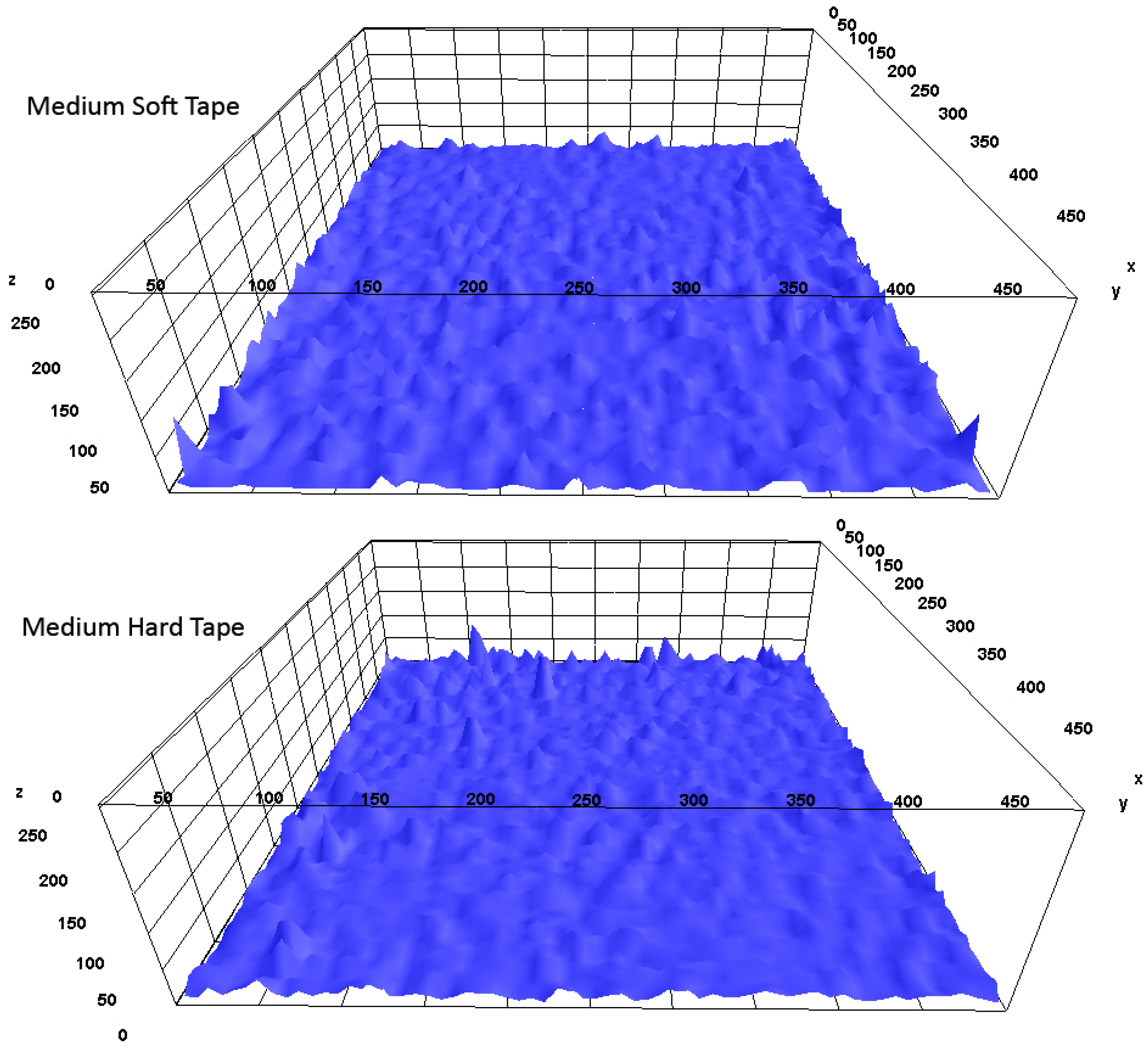
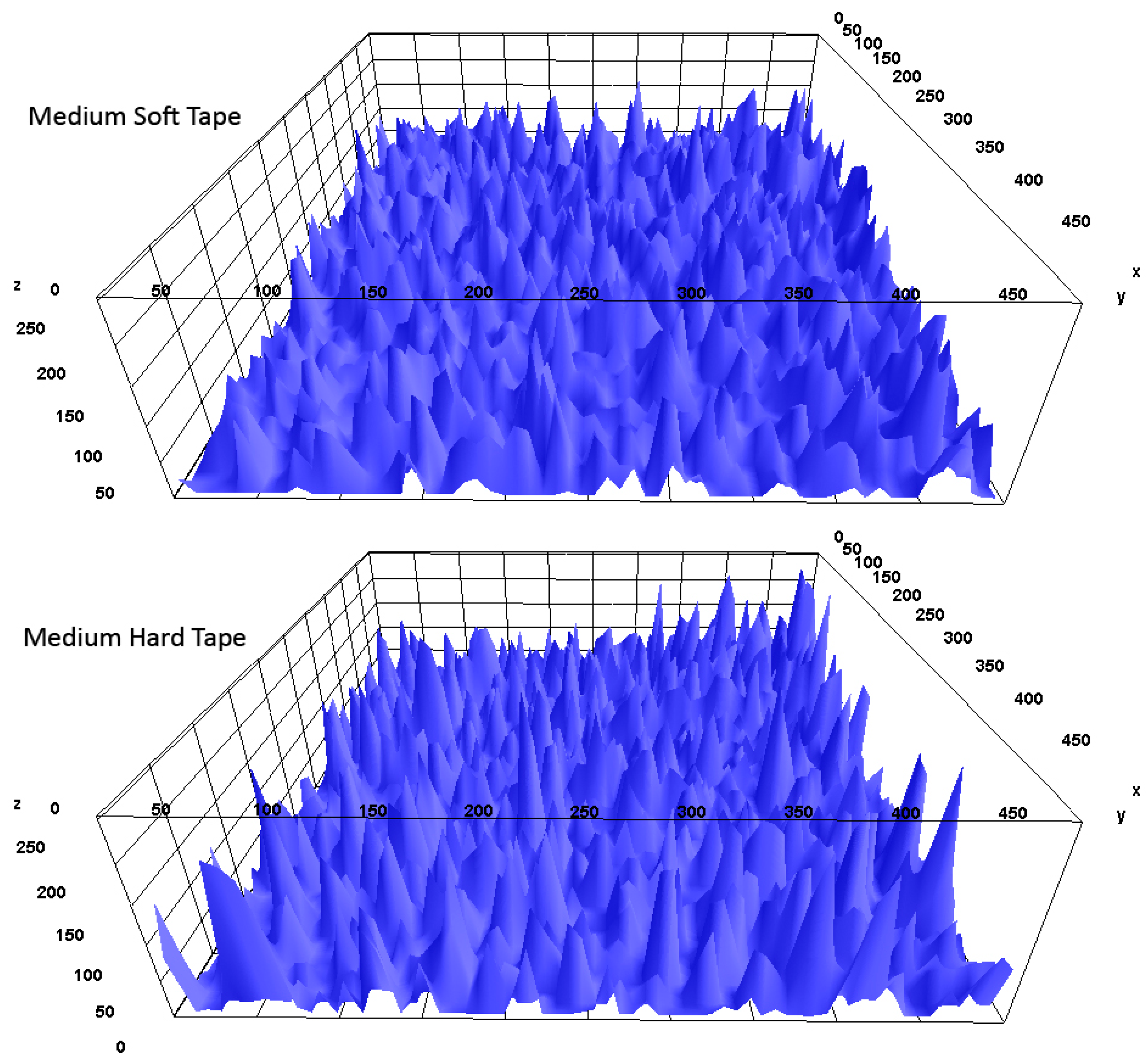
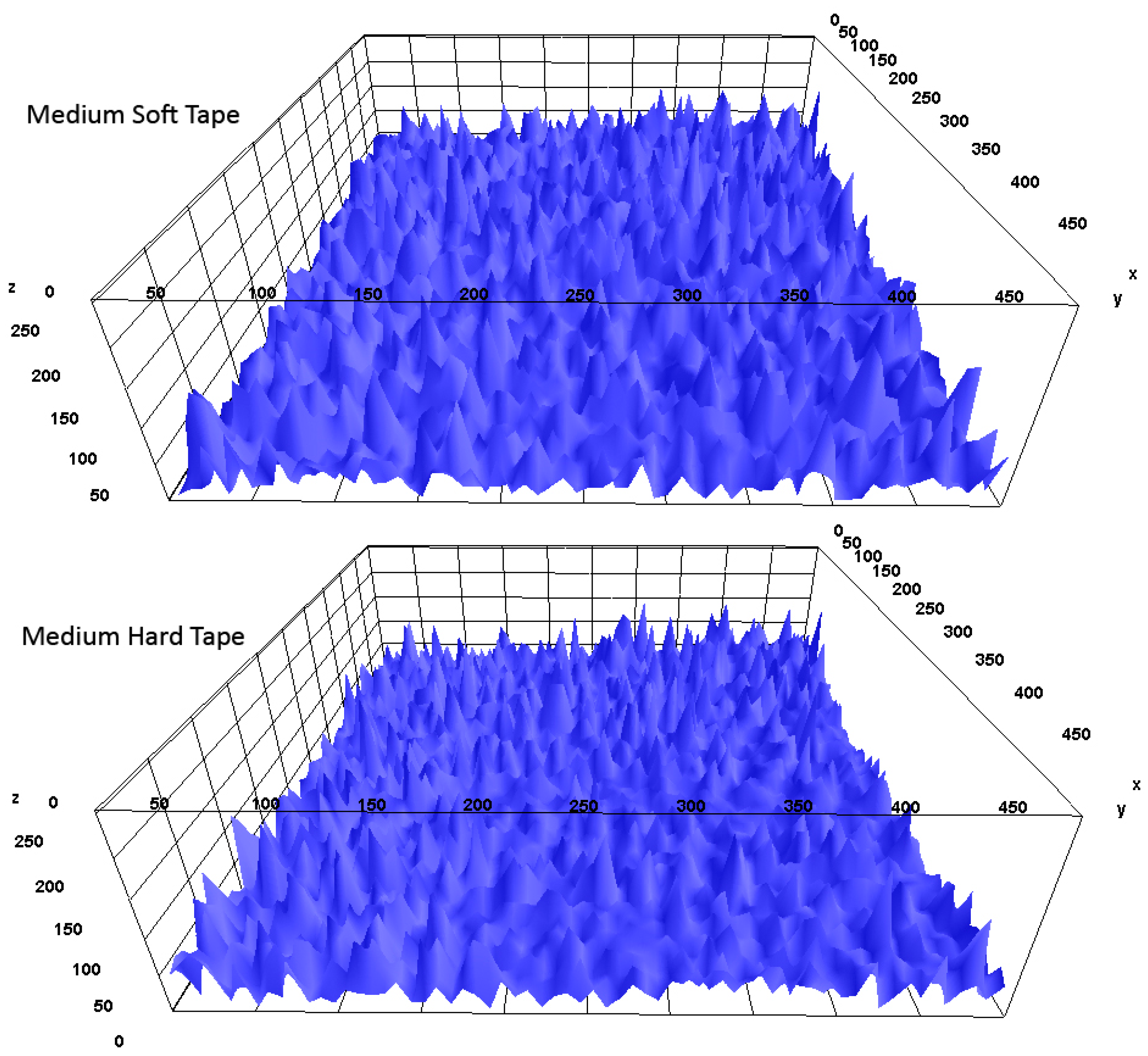
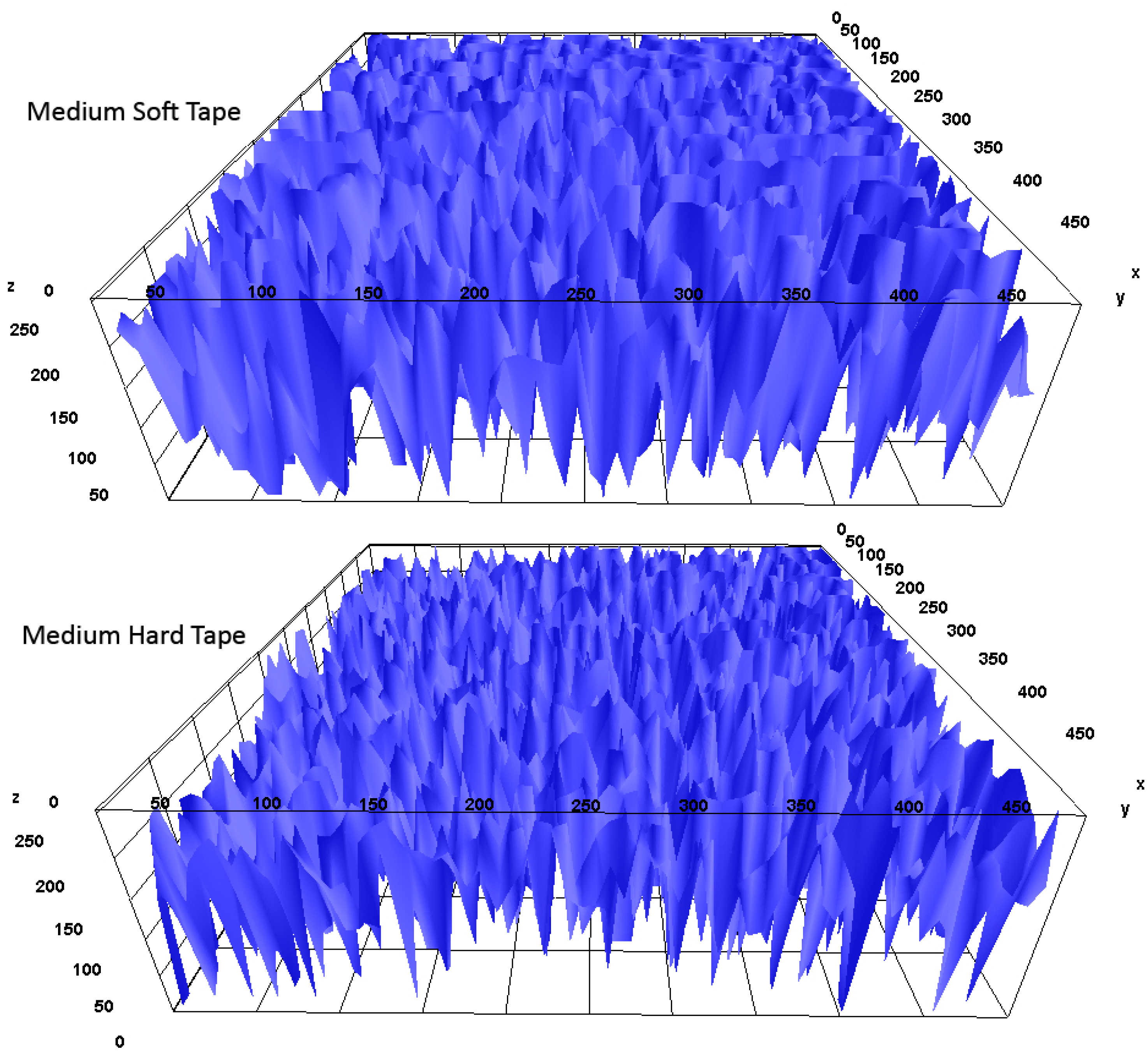
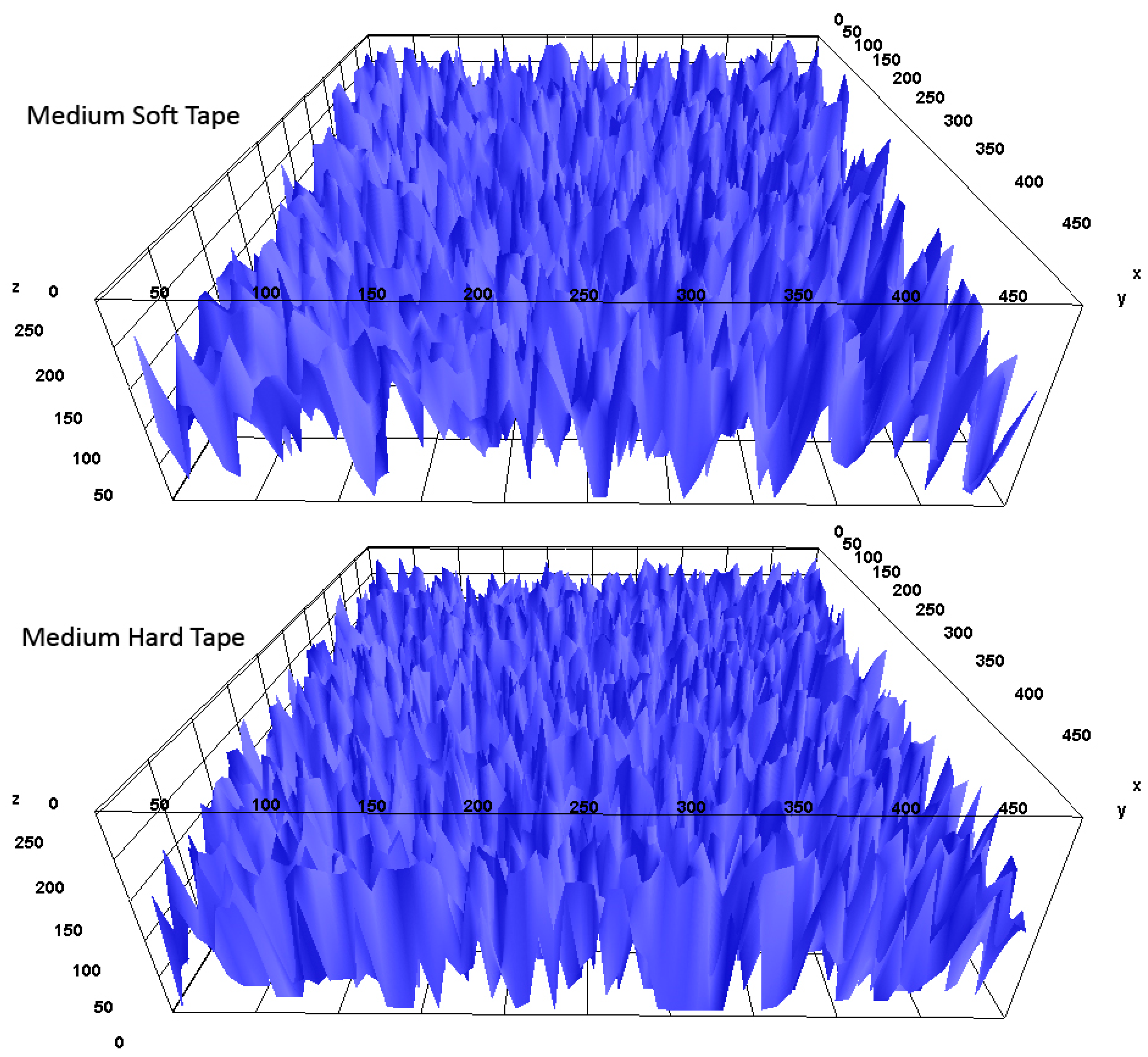
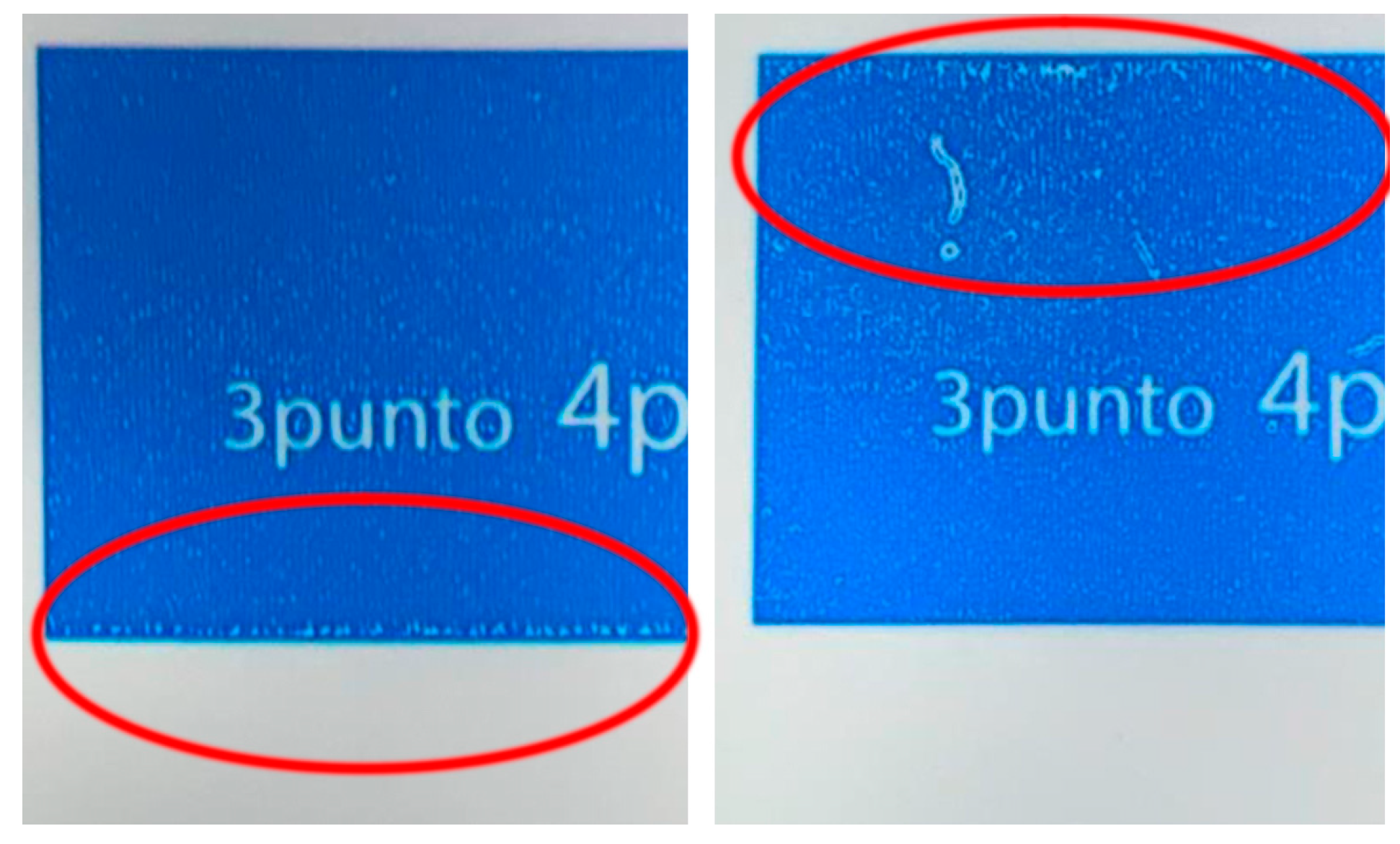

| Pattern Number | Pattern Resolutions |
|---|---|
| 1 | 1500 lpi tonal value 60% |
| 2 | 1000 lpi tonal value 60% |
| 3 | 1500 lpi tonal value 50% |
| 4 | 1000 lpi tonal value 50% |
| 5 | 1500 lpi tonal value 40% |
| 6 | 1000 lpi tonal value 40% |
| 7 | 1500 lpi tonal value 30% |
| 8 | 1000 lpi tonal value 30% |
| Pattern 1 111101111010 011001001100 110110111011 100110011001 111001111110 011011100100 100110011011 110110111001 011001001100 111011101100 100110011011 111110111011 | Pattern 3 111011001101 001100110011 001100110101 110011001100 110101100111 001100110011 001001011101 110011001100 101010110011 001100110111 111001010101 110011001100 | Pattern 5 110011001000 000100100110 001100110100 010010001001 110111000111 001000110010 100001011101 110011001000 001100110001 001000100010 100011001101 010010001000 | Pattern 7 000101000100 100010011001 010101010100 001001100010 010001010001 010010001000 000100010100 001000100010 010001000101 100010010100 000100010100 001000100010 |
| Pattern 2 110011110011 110001100001 111010110011 011100011100 011110011100 110111110110 100011100011 110011110011 111110111110 011100011100 011110011100 110011110011 | Pattern 4 001100000110 001011011010 110000110001 110001110001 011011001011 001110000110 001110001110 011001011011 110001110001 110001110001 001011001010 000110001110 | Pattern 6 101101001000 110000111001 111001111000 000011110111 000110000110 000110000110 101000101001 110000110000 110000111001 000111000101 000110000110 000101000110 | Pattern 8 110000110000 110000000000 000110000000 000110000000 000001000010 110000110000 110000110000 001000001000 000111000110 000110000110 000001000001 110000110000 |
| Substrate | PVC | PET | ||||||
|---|---|---|---|---|---|---|---|---|
| Tape | Medium-Hard Tape | Medium-Soft Tape | Medium-Hard Tape | Medium-Soft Tape | ||||
| SID | Graininess | SID | Graininess | SID | Graininess | SID | Graininess | |
| Non-Pattern | 1.52 | 0.15 | 1.41 | 0.27 | 1.21 | 0.21 | 1.26 | 0.12 |
| Pattern 1 | 1.55 | 0.13 | 1.61 | 0.14 | 1.29 | 0.19 | 1.4 | 0.08 |
| Pattern 2 | 1.64 | 0.06 | 1.55 | 0.16 | 1.31 | 0.19 | 1.4 | 0.07 |
| Pattern 3 | 1.51 | 0.15 | 1.62 | 0.07 | 1.37 | 0.08 | 1.34 | 0.11 |
| Pattern 4 | 1.66 | 0.04 | 1.51 | 0.17 | 1.43 | 0.03 | 1.4 | 0.04 |
| Pattern 5 | 1.32 | 0.29 | 1.25 | 0.45 | 1.2 | 0.27 | 1.14 | 0.35 |
| Pattern 6 | 1.44 | 0.15 | 1.38 | 0.21 | 0.86 | 0.48 | 1.13 | 0.37 |
| Pattern 7 | 0.82 | 0.41 | 0.91 | 0.31 | 0.2 | 0.85 | 0.24 | 0.76 |
| Pattern 8 | 0.66 | 0.73 | 0.65 | 0.59 | 0.52 | 0.63 | 0.55 | 0.55 |
Disclaimer/Publisher’s Note: The statements, opinions and data contained in all publications are solely those of the individual author(s) and contributor(s) and not of MDPI and/or the editor(s). MDPI and/or the editor(s) disclaim responsibility for any injury to people or property resulting from any ideas, methods, instructions or products referred to in the content. |
© 2024 by the authors. Licensee MDPI, Basel, Switzerland. This article is an open access article distributed under the terms and conditions of the Creative Commons Attribution (CC BY) license (https://creativecommons.org/licenses/by/4.0/).
Share and Cite
Kesan, N.; Sahinbaskan, T. Elimination of the Solid Graininess Issue with Different Micro-Pattern Structures at Flexo Printing. Appl. Sci. 2024, 14, 8130. https://doi.org/10.3390/app14188130
Kesan N, Sahinbaskan T. Elimination of the Solid Graininess Issue with Different Micro-Pattern Structures at Flexo Printing. Applied Sciences. 2024; 14(18):8130. https://doi.org/10.3390/app14188130
Chicago/Turabian StyleKesan, Nehar, and Turkun Sahinbaskan. 2024. "Elimination of the Solid Graininess Issue with Different Micro-Pattern Structures at Flexo Printing" Applied Sciences 14, no. 18: 8130. https://doi.org/10.3390/app14188130






